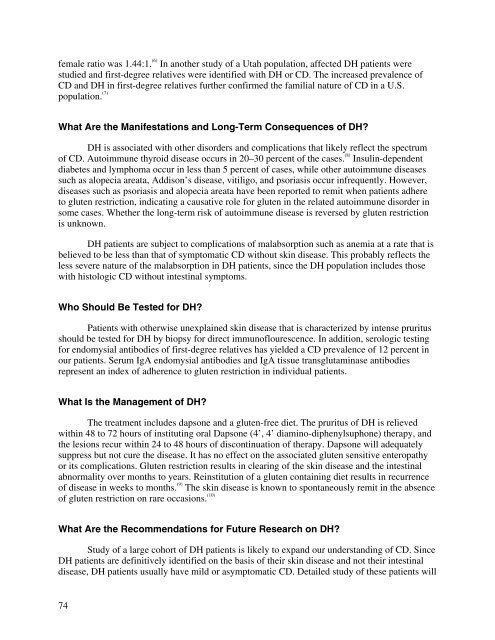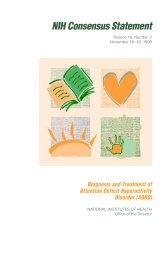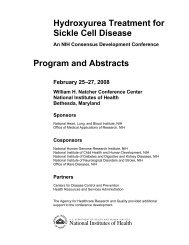Celiac Disease - NIH Consensus Development Program - National ...
Celiac Disease - NIH Consensus Development Program - National ...
Celiac Disease - NIH Consensus Development Program - National ...
You also want an ePaper? Increase the reach of your titles
YUMPU automatically turns print PDFs into web optimized ePapers that Google loves.
female ratio was 1.44:1. (6) In another study of a Utah population, affected DH patients werestudied and first-degree relatives were identified with DH or CD. The increased prevalence ofCD and DH in first-degree relatives further confirmed the familial nature of CD in a U.S.population. (7)What Are the Manifestations and Long-Term Consequences of DH?DH is associated with other disorders and complications that likely reflect the spectrumof CD. Autoimmune thyroid disease occurs in 20–30 percent of the cases. (8) Insulin-dependentdiabetes and lymphoma occur in less than 5 percent of cases, while other autoimmune diseasessuch as alopecia areata, Addison’s disease, vitiligo, and psoriasis occur infrequently. However,diseases such as psoriasis and alopecia areata have been reported to remit when patients adhereto gluten restriction, indicating a causative role for gluten in the related autoimmune disorder insome cases. Whether the long-term risk of autoimmune disease is reversed by gluten restrictionis unknown.DH patients are subject to complications of malabsorption such as anemia at a rate that isbelieved to be less than that of symptomatic CD without skin disease. This probably reflects theless severe nature of the malabsorption in DH patients, since the DH population includes thosewith histologic CD without intestinal symptoms.Who Should Be Tested for DH?Patients with otherwise unexplained skin disease that is characterized by intense pruritusshould be tested for DH by biopsy for direct immunoflourescence. In addition, serologic testingfor endomysial antibodies of first-degree relatives has yielded a CD prevalence of 12 percent inour patients. Serum IgA endomysial antibodies and IgA tissue transglutaminase antibodiesrepresent an index of adherence to gluten restriction in individual patients.What Is the Management of DH?The treatment includes dapsone and a gluten-free diet. The pruritus of DH is relievedwithin 48 to 72 hours of instituting oral Dapsone (4’, 4’ diamino-diphenylsuphone) therapy, andthe lesions recur within 24 to 48 hours of discontinuation of therapy. Dapsone will adequatelysuppress but not cure the disease. It has no effect on the associated gluten sensitive enteropathyor its complications. Gluten restriction results in clearing of the skin disease and the intestinalabnormality over months to years. Reinstitution of a gluten containing diet results in recurrenceof disease in weeks to months. (9) The skin disease is known to spontaneously remit in the absenceof gluten restriction on rare occasions. (10)What Are the Recommendations for Future Research on DH?Study of a large cohort of DH patients is likely to expand our understanding of CD. SinceDH patients are definitively identified on the basis of their skin disease and not their intestinaldisease, DH patients usually have mild or asymptomatic CD. Detailed study of these patients will74







